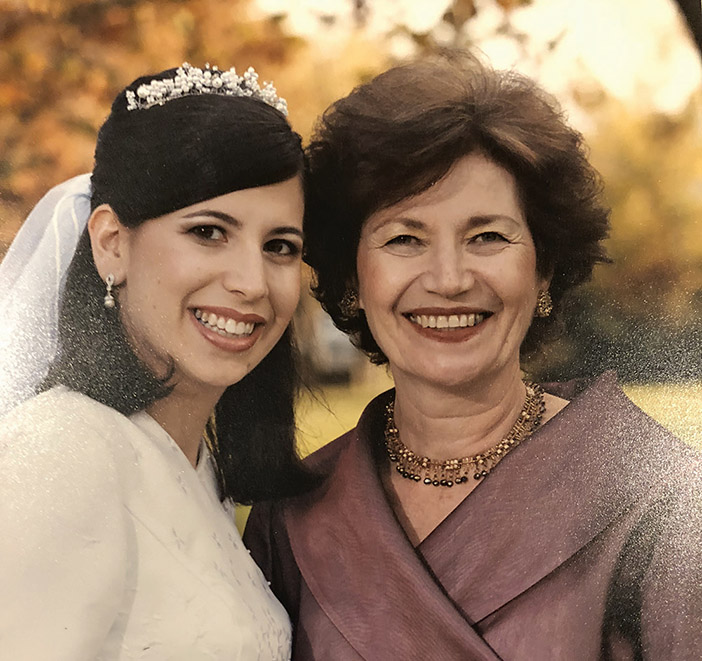
“בנתה משפחה מאוחדת באהבה מלאה, She built a unified family with complete and total love.” It is a simple yet profound inscription so befitting my mother, Lenore Malina, z”l. She never sought pizzazz or material goods; her objective was to build a cohesive and happy family, a mission that she pursued with passion and achieved with honor.
All 18 of my mother’s grandchildren, hailing from near and far, hovered around her newly erected tombstone in the unrelenting Beit Shemesh heat. The older kids could decipher the inscription we chose for her, the words so aptly reflecting her most important life mission.
Much has transpired since we buried my mother here seven months ago. My youngest sister had a baby boy named for my mother, my nephew is engaged to be married, and so many other less- dramatic family events occurred that she would have relished. But truthfully, my mother has been absent for much longer than seven months. Over the last decade, my mother suffered from a debilitating and progressive neurologic disease that stripped her of her mental and physical abilities. She was unable to recognize most of the grandchildren here who called her Savta.
But my memories precede the last decade. My mother labored to raise all five of us: She drove hundreds of carpools, studied for tons of spelling tests, and rocked us through dozens of ear infections and illnesses. And although she viewed it as a labor of love, labor it was. And just as it was time for her to enjoy the fruits of her labor, the 18 grandkids who have blessed us over the past decade, my mother faded. She would have relished grandmothering them and being a part of their lives.
And yet, there is some consolation in knowing that her children and grandchildren are the living witnesses of her legacy; they bear her values, her life’s lessons of education and stability, caring and wisdom. Her presence is so strongly felt in the way that we educate our own kids. Her unwavering loyalty to family and modeling of kibud av va’em to her own mother and mother-in-law are standards to which we have aspired, although we have not always successfully met the exceptionally high bar she set.
I think that the midrash relayed in Masechet Menachot 29b speaks to this idea of the past shaping the future. The story describes how, when Moshe went up to Har Sinai to get the luchot, Hashem was taking His time preparing calligraphic embellishments to the letters. Moshe asks Hashem what is taking so long, and Hashem responds that He is preparing the Torah for Rabbi Akiva, who will “doresh” (decipher and understand) all of these designs. Moshe is then actually transported in time (akin to a time machine) and finds himself in Rabbi Akiva’s beit midrash. When he enters, Moshe is flustered by what is being learned. Hashem comforts Moshe and informs him that it is actually all “Halacha l’Moshe miSinai,” that it all derives from Moshe. In this way, Moshe’s echo resounded in that beit midrash, despite the many years separating Har Sinai and that place of study. Although there was no direct interpersonal contact between Moshe and Rabbi Akiva, the Torah values that Moshe relayed were very palpable and recognizable in, and to, future generations. Similarly, although my mother would not have recognized many of the grandchildren hovering around her tombstone today, they embody and carry forth her dreams. My mother was principled and a staunch Zionist, which I believe influenced the home that my sister and her family have made in Israel. The past and future are inextricably linked, even if temporally disconnected.
The fact that my mother died on the holiday of Tu B’Shvat is so fitting. The holiday is first documented in the Mishna and falls during the winter, when trees are bare, not a time when one might expect a holiday that celebrates the glory of nature. However, it is at a time that we must celebrate the potential of the trees, when the sap begins to travel up from the roots, enabling the buds to form and flowers to bloom during the spring. The connection between the bare trees and the ultimate fruit may not be apparent, but it is there. Furthermore, we cannot assess the impact or potential of the flowers based on their current state. We may have to wait a few months, or generations, to see their full potential. In this way, while my mother’s death was the end of her own life, it occurred on a holiday that celebrated the future generations that she influenced.
As they said goodbye at the gravesite, each grandchild carefully placed a rock on the tombstone hand-painted with their name and a decoration. These bright placeholders are a constant reminder of my mother’s legacy. The juxtaposition of the colorful rocks and the tombstone visually demonstrates that unbreakable bond between the past and the future. In this way, my mother’s grandchildren are at once both a product of and a testament to her “אהבה מלאה.”
By Dr. Vivi Malina-Furer










